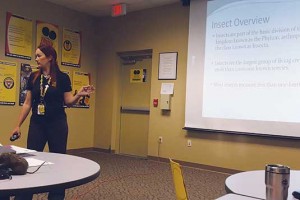
Classroom training helps ensure PMPs know how to do their jobs properly. Photo: Truly Nolen
Whether offered in-house or off-site, a classroom setting offers a convenient training option.
Whether you’re a seasoned veteran or just starting your career, every pest management professional (PMP) has had at least some form of training in a classroom.
It’s the most common way for PMPs to gain the knowledge they need to become registered and licensed in their states. It’s also how many earn their continuing education units (CEUs). However, the learning shouldn’t stop there.
“If that’s all you’re doing, you’re really cheating yourself,” says Doug Foster, owner of Burt’s Termite & Pest Control in Columbus, Ind.
In addition to educational sessions provided by manufacturer reps and product distributors, many companies offer their own training classes to ensure PMPs are ready for anything while on the job.
Foster supplements required training throughout the year by holding training sessions on a variety of topics, such as proper species identification as well as the correct and best use of products. He also makes sure his employees know how to pronounce and spell not only the names of the products they use, but their active ingredients as well.
“Once you do that, you’re setting yourself apart from other people,” Foster says. “It seems like something minor, but when the guys feel confident about knowing stuff that other people don’t know, it gives them more confidence in the work they do.”
Foster makes his commitment to classroom training clear by putting it on the schedule.
“[Training] is mandatory because it’s too easy to say, ‘We’ve got all these stops we’ve got to get done,’” he says.
Set time aside

Mark Ringlstetter and Scott Svenheim, ACE, are part of Truly Nolen’s training team. Photo: Truly Nolen
Because summer is the busiest time of year for the pest management industry, the winter months are an ideal time to hold training sessions. Many companies find the time November through February.
Bryan Vaughan, training and technical specialist for Loyal Termite & Pest Control in Henrico, Va., says he schedules training time for his PMPs in the mornings.
“That way, their first stop isn’t quite as early so we get those training hours in,” Vaughan says.
Truly Nolen, which has been in business since 1938, launched its training department in the late 1980s. It now boasts Truly University facilities in Florida and Arizona, and offers an extensive training program throughout the year.
“A lot of people come into this industry brand new, not knowing the industry, and are amazed and shocked when they learn how much there is to learn,” says Scott Svenheim, ACE, the company’s director of e-training. “It opens people’s eyes to the fact that this is an actual profession, and you need to learn about that profession if you want to be successful.”
Indeed, pest management is more than simply using products. To do it right, PMPs need to know how to correctly identify pests and determine which actions or products will treat an infestation.
It’s helpful to keep specimens on hand so PMPs get a clear understanding of what they may encounter on the job. Smartphones also are good tools to use to share knowledge.
“If I see certain situations in an account, I’ll take photos and a short video with my iPhone,” Foster says. “We then use that in our training.”
Role-playing is also a great teaching tool, Foster notes. Practicing what to say to a customer helps ensure PMPs are professional, polite and knowledgeable.
“If a customer asks me a question that maybe I haven’t heard before, I’ll write that down and we’ll bring that up for our role-play,’” he adds. “I know if I’m getting asked that, the other guys are going to get asked that, too.”
In a classroom setting, PMPs can share their ideas with their classmates. When they ask a question, everyone hears the answer. Plus, they get an immediate answer.
Vaughan says it helps to remind PMPs that there is no such thing as a stupid question. “Make sure they feel comfortable asking you a question,” he says.
Show, don’t tell
Demonstrating how to spot the presence of pests and how to prevent pests from entering structures also is helpful. Truly Nolen’s new training facility in Tucson features a mock setup of a house, so PMPs can experience what they will eventually encounter on the job.
“We’ve replicated almost any imaginable scenario a technician would see on any given day in a house,” says Mark Ringlstetter, Truly Nolen’s technical and training director. “They can have a really good feel for what they are going to come face-to-face with in the field.”
Of course, not every pest management company has the resources to replicate a home environment. You can, however, contact local, state and national organizations for training resources. Your state’s pest management association, the U.S. Dept. of Agriculture and the National Pest Management Association are good places to start. Institutions known for pest research and education, including Virginia Tech, Texas A&M, Purdue University and the University of Florida, offer current, reliable information. Local community colleges may also be a good option. No matter the source, training is important.
“We hear all the time from people coming here from other companies that probably want to do a lot of training, but maybe they get stuck in short-term thinking; they think it’s better to get people out there and do the job rather than spend the time and the money to get them trained,” Truly Nolen’s Svenheim says. “But we’re just the opposite. We’ve found the more we train people and make them knowledgeable, the longer they stay around.”
Sure, testing and certification along with constantly changing federal, state, and local regulations are just a few of the reasons why training is important. They aren’t the only reasons, however. Whether it’s learning how to recognize pests and treat an infestation, how to prevent pests from entering structures, how to properly use pest management tools or how to stay safe on the job, classroom training can ensure PMPs know how to do their jobs properly.
“The great thing about pest control is, even after you’re certified and registered, you’re always learning,” Vaughan concludes.
Check out “5 tips for training that sticks” here.
You can reach PMP Managing Editor Diane Sofranec at dsofranec@northcoastmedia.net or 216-706-3793.
Leave A Comment